Whether you just took your first Brazilian Jiu-jitsu class and are looking to start your journey or you're a season vet. We have put together a complete guide to help you choose the best bjj gi for your needs. The Jiu-jitsu gi has evolved a lot since Jigoro KAno created the first unbleached heavy white cotton gi prototypes.
Since the early 1900s the bjj gi has gone through several modifications to be adatped for modern day competition purposes. Also, over time colors, designs and new weaves have been created. Like single and pearl weaves and even hemp weaves. To find the best bjj gi for your needs you will need to know the differences between pearl vs. gold weave, figure out your correct size, and even how to keep your gi looking fresh.
The first question you should ask yourself when searching for the perfect BJJ gi is whether it is for competition or regular training? If you are looking for a BJJ for competitive purposes you should have an understanding of the rules of these competitions.
Let’s look at some overall competition BJJ gi requirements.
The International Brazilian Jiu-Jitsu Federation (IBJJF) has developed strict guidelines in regard to your gi. If you are in competitions, the only authorized colors are white, black, and blue. Your top and bottom must match in color. Painted gis are not permitted unless done in an approved patch area. These must be for sponsorships only.
You can have patches on your competition gi only in approved areas as demonstrated by the diagram below. If a patch is not entirely sewn or in an approved area, it will be removed by a gi inspector.
Following this BJJ gi buying guide will ensure you comply with regulations.

Photo Courtesy of IBJJF.com
Your belt is to be 4-5 cm in width and colored according to rank. The belt will have a black tip except for black belts which will have a red or white tip.
The belt is wrapped twice around your waist and tied tight enough to hold your gi closed. It should be double knotted and hang no longer than 30 cm from the knot.
Pants are to be no more than 5 cm above the ankle bone and should be tight enough to raise the ankle when your knees are bent.
Men are not permitted to wear shirts of any kind underneath the gi. Women are required to wear a tight elastic shirt that will not interfere with the gi. Compression shorts are standard for both men and women.
The United States Grappling Division requires merely that your gi is correctly fitted for your body type and is free of tears, rips, or odors. All colors and designs are permitted as long as they are free of profanity or inappropriate content.
Gi Guidelines
Gis are to be constructed of cotton or similar material and in good condition. The material may not be excessively thick or stiff to the point where it hinders the opponent from executing a submission.
The gi top must be made of single weave, gold weave, double weave or a similar weight material.
Colors may be black, white or royal blue. No combined colors will be allowed (e.g. white gi with blue pants or a white gi with black lapels).
The jacket and the trousers should be of a uniform color and correspond to the following color references:
The jacket is to be of sufficient length, down to the pelvis.
The pants are to be tied securely at the waist above the buttocks. If they are grabbed and pulled down, they should remain affixed where they are secured at the waist. They must be of appropriate length, reaching a point no more than 8cm up from the ankle.
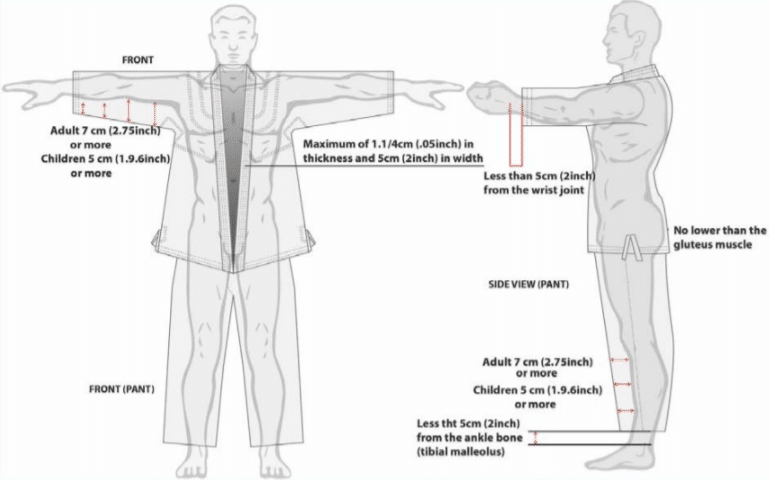
Patches and embroidery may be securely affixed only in prescribed areas on the gi that do not impede regular gripping of the gi. Any patches with unfixed edges or tears must be removed.
Patch Regulations for the gi are as follows:
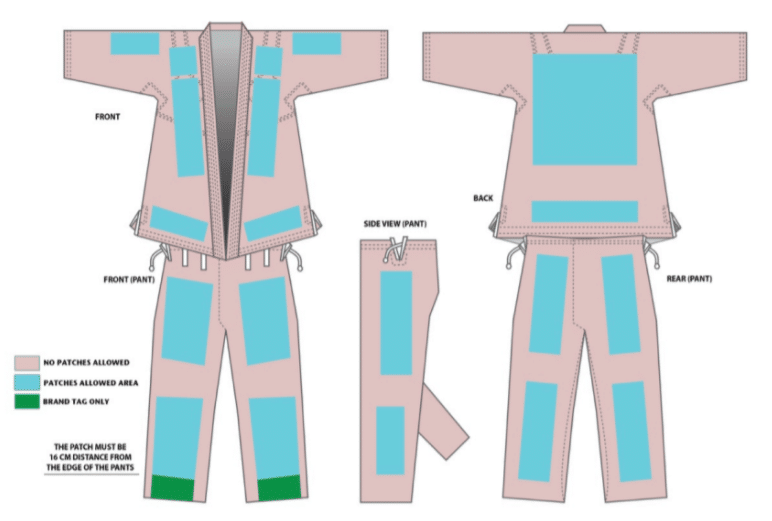
When looking for a gi for competition it’s important to review the overall rules and regulations for tournaments prior to investing in a new gi.
Depending on the type of gym you train in there may be strict rules in place regarding color, design, and patches. While the rules may vary a bit there are some that tend to be fairly common.
What gi you wear for training will depend on your gym's affiliation and your instructor’s preferences. Some instructors require that you wear only white and others don’t care at all.
Generally speaking, if you stick to white, blue or black colored BJJ gis you should be in the clear.
However, some BJJ schools that are more traditional may only allow white or blue colored gis. For example, Gracie affiliated gyms prefer white colored BJJ gis. Different schools have different guidelines for training as well. The Art of Jiu-Jitsu Academy requires all athletes to have white gis. Alliance Sao Paulo allows blue, black, and white.
Color requirements can depend on instructor and rank. You can always check with your school before buying.
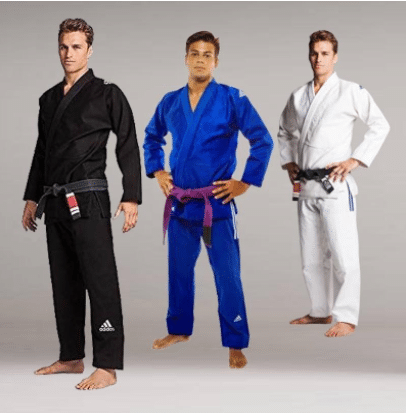
Photo courtesy of kampfsportwelt.com
Shown above are the three most popular colors. These typically are safe choices when it comes to colored gis.
A lot of BJJ schools have their own patches that are required to be sewn in prior to competition and regular training. It's important to check with your academy and your instructor before purchasing a BJJ gi that is heavily patched up.
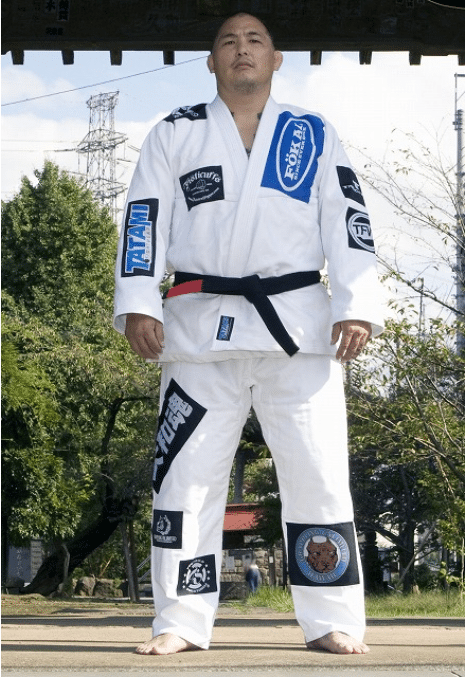
A Final Note on Training Gis
If you spend all your time training in a non-competition gi, you may find yourself feeling inexperienced when you step up against your opponent.
You want to try and keep all your gis as similar as possible, so you are not at a disadvantage at any point in your training. It's important to consider whether or not you need a training or competition gi. This will impact your decision when trying to find the best jiu-jitsu gi to suit your needs.
The best BJJ gi will be form fitting having very little loose fabric especially around the wrists, ankles, and collar. Different governing bodies have different regulations for what types of fabric to use on a gi. The IBJJF regulations require a woven fabric for juvenile, adult, master, and senior divisions.
Weaving is the process of interlacing two sets of thread to form a fabric. The weave determines the overall strength and lifespan of a gi. This is an important decision to make when trying to find the best competition gi.
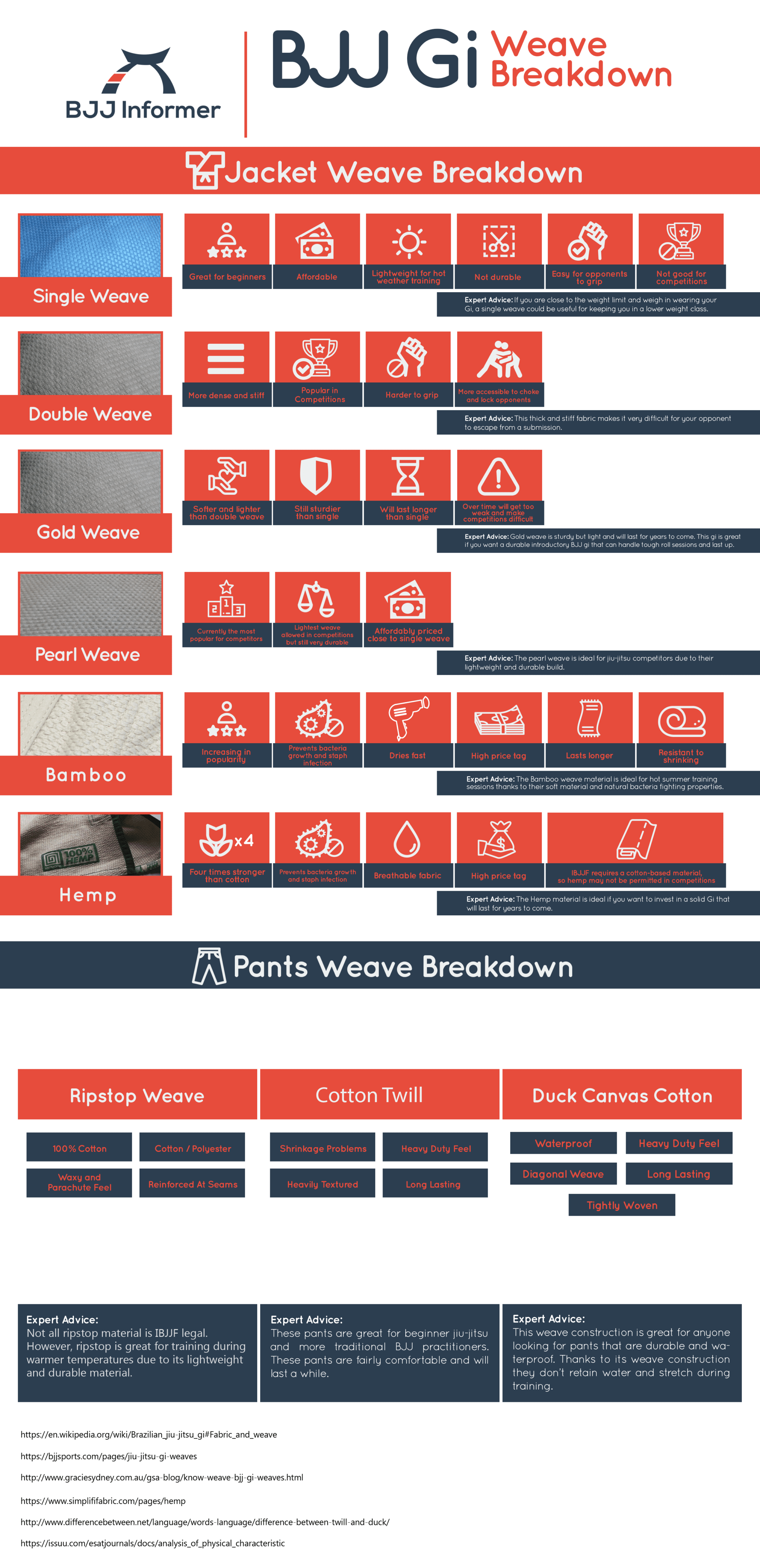
The single weave fabric is lighter and typically less expensive. It is often used for training during hot summer months. Typically these range between ( 300-550 gsm).
Expert Advice:
If you are close to the weight limit and weigh in wearing your gi, a single weave could be useful for keeping you in a lower weight class.
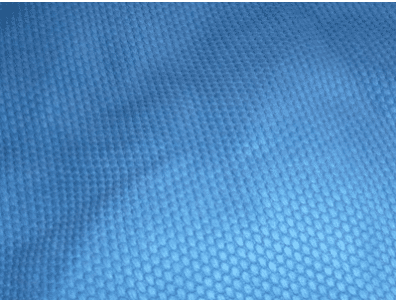
Photo courtesy of Wikimedia Commons
The double weave makes use of significantly more fabric than your standard single weave. It is heavier, harder, expensive and more durable. The stiffness of the material can be more abrasive on the skin of both your opponent and yourself. Traditionally, the double weave is found in Judo gis, however, contrary to popular belief there are jui-jitsu companys that make a double weave gi like Ronin, Tatami, Isami, and Atama.
This thick and stiff fabric makes it very difficult for your opponent to escape from a submission it is great for training during the colder winter months.
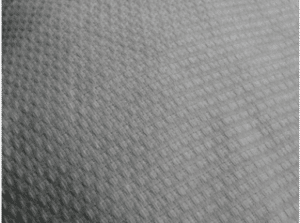
Photo courtesy of Wikimedia Commons
The Gold weave is a hybrid between the double and single weaves. These aren’t necessarily a double weave gi but not quite a single. It has the lightness of the single weave and the durability of the double weave. But the appeal of the Gold weave is it has the lightness of a single weave with all the durability benefits.
Expert Advice:
Gold weave is sturdy but light and will last for years to come. This gi is great if you want a durable introductory BJJ gi that can handle tough roll sessions and competitions.

The pearl weave is somewhere between a single and a gold weave. They tend to be very popular for competition as they are light and durable. Thanks to their construction the fabric allows air to pass through. This type of weave is characterized by the tiny pearls or bumps in the fabric and is a variation of a single weave fabric.
Expert Advice:
The pearl weave is ideal for jiu-jitsu competitors due to their lightweight and durable build.
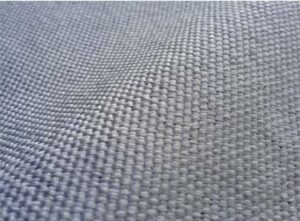
Bamboo is a softer weave and unlike cotton doesn’t shrink after multiple washes. Also, thanks to the bamboo fibers moisture absorption this fabric tends to dry faster and allows for faster evaporation of sweat. Bamboo itself is an antibacterial fibre and it is believed to help prevent bacterial build up. The big benefits to Bamboo gis are that they are soft, eco-friendly, and absorb sweat.
Expert Advice:
The Bamboo weave material is ideal for hot summer training sessions thanks to their soft material, breath ability and sweat absorption.

Hemp is great for eco-friendly BJJ practitioners. Hemp takes half the land and resources to have a good crop to process it. Similar to bamboo overtime hemp fabric softens with each wash. Hemp fabric is great for warm, humid climates thanks to its breath ability, moisture absorption and resistance to mildew.
Expert Advice:
The Hemp material is ideal if you want to invest in a solid gi that will last for years to come.
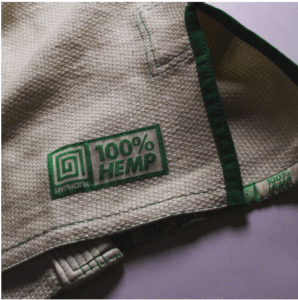
The pants for your gi primarily come in two different weaves, the ripstop weave, and the cotton drill.
The ripstop is a cotton weave blended with other materials that are not always IBJJF permitted. Ripstop is the lightest material and is also used to make the jacket. This thin material is tightly woven and smooth. It makes it difficult for opponents to grip.
This material was originally designed to stop the spread of rips and tears. Most are not legal in BJJ tournaments.
The cotton drill is the most traditional weave used in gi pants. They tend to last a long time and hold up well to wear and tear. Cotton has been the most popular pants material for decades.
Ripstop weave is one of the newer weaves and is superior compared to cotton drill weaves. Ripstop material has become popularized due to it being hard to grip, tear and it is a long-lasting material. Ripstop weave is composed of reinforced interweaves threads at regular intervals in a crosshatch pattern. One of the main advantages of ripstop aside from its light construction is it is designed to stop rips and tears before they spread throughout the weave.
Expert Advice:
Ripstop pants are great for training during due to their lightweight feel and durable material.
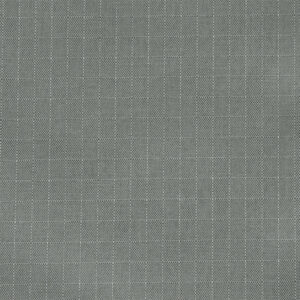
Cotton Twill pants are strong and heavily textured. Cotton drill pants last longer and are still preferred by BJJ practitioners. But over time this material shrinks more in length and width.
Expert Advice:
These pants are great for beginner jiu-jitsu and more traditional BJJ practitioners. These pants are fairly comfortable and will last a while.
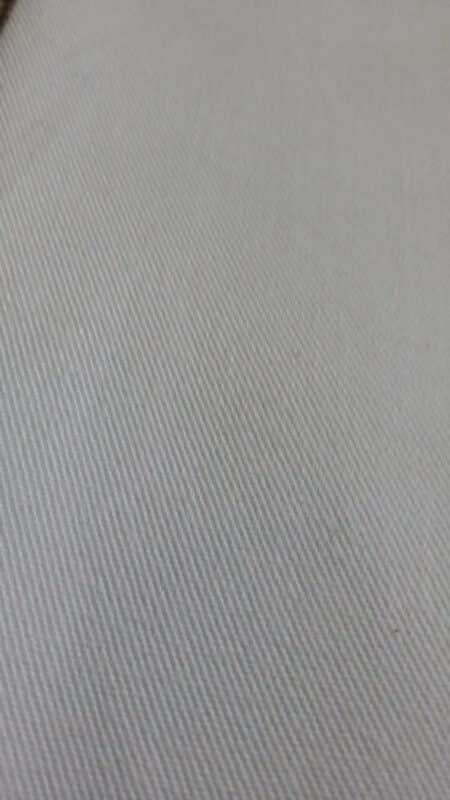
Duck Canvas Cotton is a heavy, plain woven cotton fabric. Duck canvas cotton is one of the more durable fabrics. It is considered a sports weight fabric too. Thanks to duck being a tightly woven fabric it makes it waterproof. Also, thanks to its construction it is resistant to wear and tear.
Expert Advice:
This weave construction is great for anyone looking for pants that are durable and waterproof. Thanks to its weave construction they don’t retain water and stretch during training.
The pearl weave is a hybrid between single and a gold weave. The pearl weave fabric tends to be the most popular choice for competition purposes. This gi tends to be lightweight while also durable.
The gold weave is a blend between the double and single weaves. It was the standard for competition gis before being usurped by the pearl weave.
The single weave fabric is very light and generally less costly in the short term. They are wonderful for training during hotter summer months but will wear out faster.
The double weave has twice as much fabric per square meter. Hence the name, this type of fabric is mostly used in Judo gis. However, this weave can be found in some Jiu-Jitsu gis as well. Due to the tighter woven fabric this gi will retain heat more and weigh you down.
The best jiu-jitsu gi will be form fitting having very little loose fabric especially around the wrists, ankles, and collar. To ensure proper fitting, you’ll first need to understand how your body type relates to gi sizing.
BJJ gis often come in sizes A0 – A6. The ‘A’ stands for ‘Adult,’ and the number represents the different sizes. The lower the number, the smaller the size; the higher the number, the larger the size.
These usually come in sizes marked ‘F’ following a similar sizing structure. Sizing for Jiu-Jitsu gis will vary from brand to brand, but it helps to understand how it should fit you and how it should feel.
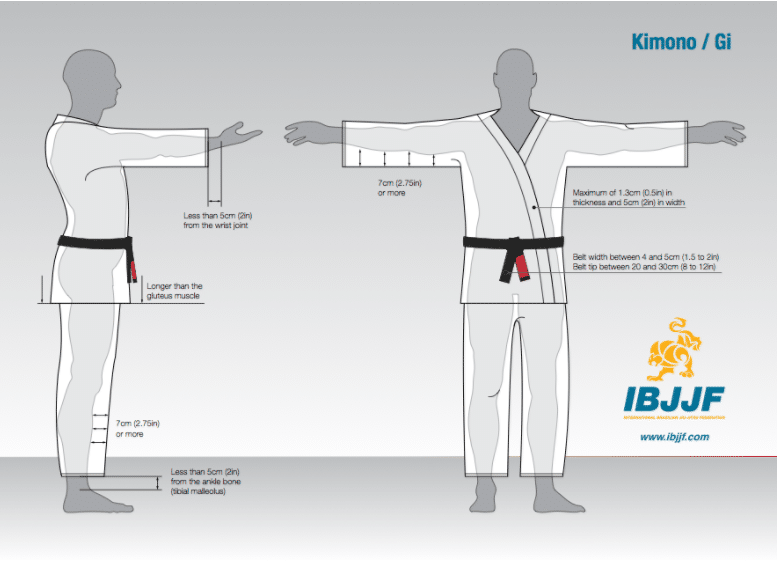
Photo courtesy of IBJJF.com
Your sleeves should reach the wrist bone and be a little loose on cuff. There should be no more than one and a half inches extending from your wrist bone to your sleeve.
For pants, they should reach your ankle bones and be a little loose on end. There should be no more than one and a half inches extending from your ankle bone to your pant leg.
When you tie your belt, it should keep your gi closed along your chest, and you need to be able to double knot your belt. The jiu-jitsu gi will allow you a full range of motion without stretching or overextending the jacket or pants.
The BJJ gi buyers guide suggests that you will be able to tell if your gi is too small for how it feels on you. Can you rotate your arms without stretching the sleeves? Can you stick your arms up in the air without your belt coming loose from your jacket? You can tell if the gi fits correctly by how you perform in it as well.
When you put on your jacket, there should be little to no extra fabric around the chest and collar. It should be firm and fit the back and buttocks only allowing you enough space to bend and rotate.
Sleeves should not extend past the bend in your wrists. With your arms fully stretched the sleeves should shorten making it harder for opponents to grip. Your pants should not hang below your ankle bone or be loose and baggy. When you crouch or bend at the knees, the perfect gi will rise and tighten up making it hard to grip.
A standard issue with cotton fabric gis is shrinkage over time. Whether you use a dryer or hang them up to dry, you are going to encounter this problem.
You can buy a pre-shrunk gi, but even they will shrink a little as you continue to wash them. Your gi can shrink as much as a full inch on your sleeves and pants. It is best to buy at a maximum legal size to allow for possible shrinkage over time.
The cost of a gi can range from $50-$300 or more, depending on what style, the brand, and where you buy it.
A significant factor determining price will be the weave. Hemp and Bamboo will cost a lot more than a single weave. There are also a lot of specialty brands out there that claim to produce higher quality gis using the same fabric.
If you are just starting out, it would be smart to invest in a single weave cotton gi. The light material and cheap price tag will be just fine to get you into the sport.
Everyone deals with smelly laundry every now and again, but you don’t want your gi to fall into the same situation. Make sure you provide it with the proper care to help prevent the spread of staph and ringworm to yourself and others.
Always leave your gi in open air after training and competitions. Closing it up entirely in a gym bag and forgetting about it for a few days will result in the spread of fungus and other bacteria. When drying your gi, dry it separately from the rest of your clothes on warm heat. If time permits, the best way to dry your gi is out in the open on a clothesline.
Heavy detergents like Gain or Bounty can damage your gi. If possible use the gentle soaps made for baby clothes like Dreft. Mild cleaners will extend the lifespan of your gi and keep your more comfortable during training.
Now that you have made it through the complete BJJ gi buyers guide you should know everything there is to know about finding the best jiu-jitsu gi that's right for you.
You should know: